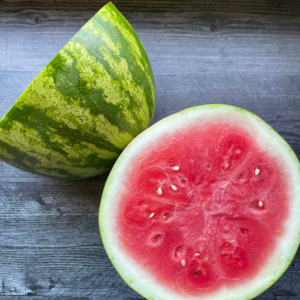What’s a Pollinator Melon? (How Seeded Watermelons Come to Be)
Ever heard of “pollinator melons?” Neither had I, until I married a farmer. Our parents raise the melons for the CSA fruit share, and my mother-in-law shared with me an interesting science lesson on how seedless watermelons come to be.
It’s all thanks to something called a pollinator melon.
But let’s back up. Seedless watermelons were invented around 50 years ago, and they have virtually no seeds. (Those mini white seeds don’t count — they are the immature version of the black seeds and can be eaten). How do you get a plant to NOT create seeds?

If you remember your biology class, chromosomes are the building blocks that determine the traits of all living things (including watermelons). Watermelon breeders discovered that if you cross a “diploid” plant (which has two sets of chromosomes) with a tetraploid watermelon plant (which has four sets of chromosomes), you get a “triploid” plant (which has 3 sets of chromosomes). The triploid plant produces a “sterile” plant, meaning its fruit will not contain seeds.
A seedless watermelon is therefore a sterile watermelon (aka the botanical version of mules). It is created by crossing the male pollen from a watermelon containing 22 chromosomes per cell, with a female watermelon flower containing 44 chromosomes per cell. When the seeded fruit matures, the resulting white watermelon seeds inside have 33 chromosomes, making it sterile and incapable of producing seeds.
Before you start panicking… this is not GMO. There is no genetic modification going on. This is simple cross-breeding. Interestingly, seedless watermelons still need to be pollinated by their seeded parent, so growers will plant seeded and seedless in their field. On our farm, we plant a seeded plant roughly every 4th plant. We call these seeded plants “pollinator melons.” The pollinator melon plants also form melons, but they are tasteless and bland, and are never harvested. Their sole purpose in the field is to help birth the seedless melons in the neighboring beds.
Seedless watermelon makes up for 92% of all watermelon sales in the United States. Seeded varieties just aren’t popular in the market. Consider for a moment how much space seedless watermelons take up in a farmer’s precious fields. Not only does the farmer have to set aside acreage for the actual seedless watermelon plant, but he must also set aside bed feet for plants just to pollinate them (ground he could use to grow something else). This may be one of the reasons seedless melons are more expensive.
